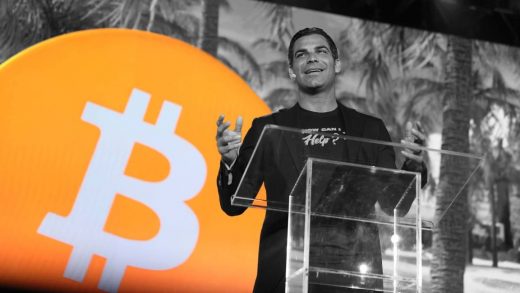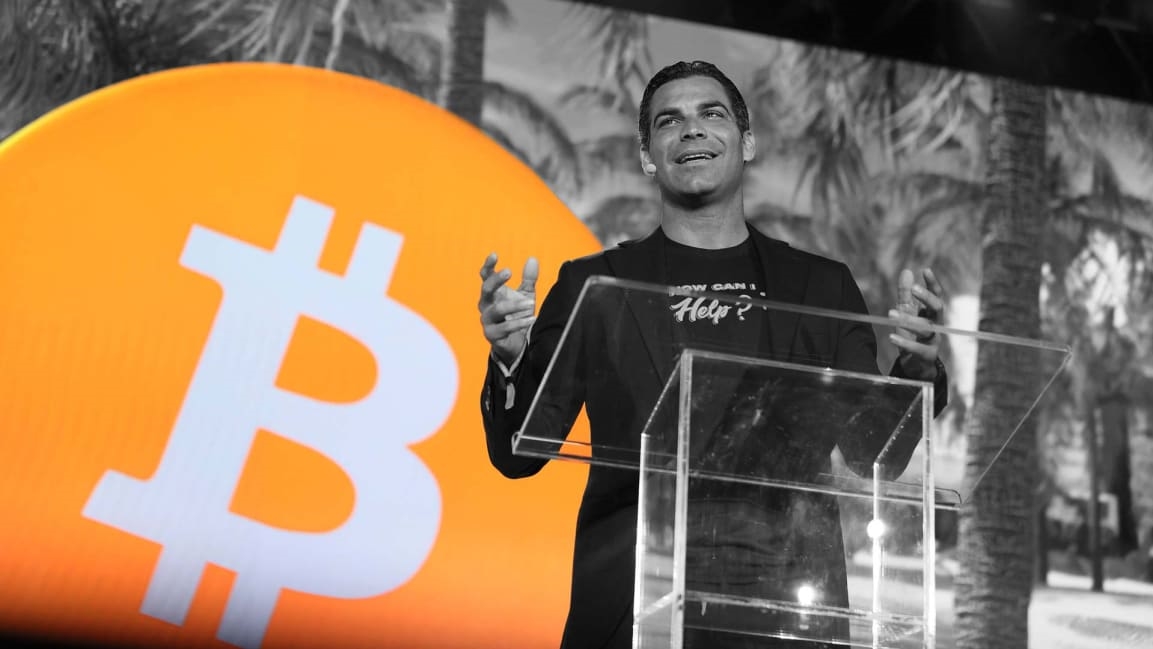Miami is still trying to figure out what it means to be a crypto capital
In January 2021, Miami Mayor Francis Suarez took to Twitter to declare his city the new cryptocurrency mecca. “The City of Miami believes in #Bitcoin,” he tweeted, “and I’m working day and night to turn Miami into a hub for crypto innovation.”
Those weren’t just empty words: That same year, Suarez launched MiamiCoin, a crypto coin for the city that generated $5 million for the city since its launch. And with no state income tax and a corporate tax rate of just 5.5%, it wasn’t hard to see the appeal a place that’s nicknamed The Magic City might have to a still-fledgeling industry that is sometimes itself accused of magical thinking. And it’s sort of working: For instance, crypto giant Blockchain.com left New York City and leased a massive office in the city earlier this year.
“There is an incentive for any place to be the hot new place,” economist Jodi Beggs told Fast Company. “If, for no other reason, then your branding city is associated with a hot new thing. And, honestly, that’s kind of Miami’s jam, right?”
Earlier this month, at a kick-off event for Bitcoin 2022, the world’s largest Bitcoin convention that’s held in Miami, Suarez was at it again. Proudly posing in front of the city’s prized new art piece, a 3,000-pound statue of an android-esque bull that the Miami Herald astutely pointed out “looks like a giant Transformer,” the mayor exclaimed that “we need to integrate Bitcoin into every aspect of our society.”
But if the current state of Miami’s Bitcoin integration is any indication of what a crypto city might look like, it’s safe to say both the concept and the city have a long way to go.
Beggs, who has previous experience in the crypto analytics space, grew up outside the city and is very familiar with the Miami ethos that has begun attracting interest from the crypto world.
“There was already somewhat of a culture of, ‘hey, we’re going to go do our somewhat non-traditional finance activity where the weather’s nice.’ And I think that the finance players taking their Bitcoin business to Miami is completely within that same,” she says.
Miami’s flirtations with the crypto business is noticeable everywhere you look. Immediately upon entering the city from the airport, you’re greeted with billboards advertising NFT lines; it’s not uncommon to see a Bitcoin ATM next to a regular one while driving around the city. (Beggs says that the idea of a Bitcoin ATM doesn’t even make sense: “The whole point of crypto is that you don’t need any ATMs.”)
The reality of Miami’s blockchain-centric ambitions, though, doesn’t live up to the hype radiating from Suarez’s tweets. Miami is fifth in the country for crypto investment, according to Bloomberg. San Francisco, New York, Los Angeles, and Albany all outrank it in terms of money generated from crypto investment deals. Also, the vaunted MiamiCoin has seen poor returns for early adopters. According to CoinMarketCap, the coin peaked at $0.05 last September. It’s currently hovering around $0.002, which makes its future feel hazy at best. (Mayor Suarez’s office did not respond to a request for comment.)
Making matters worse, this year’s Bitcoin 2022 wasn’t the slam dunk that many seemed to expect it to be. The convention had a lukewarm reception among some of Bitcoin’s biggest diehards. Mr. Whale, a cryptocurrency-tracking Twitter account with half a million followers, declared the event a “complete failure.” “Not only were over 70% of the seats empty, but many big guests like [El Salvador’s President] Nayib Bukele didn’t even show up,” Mr. Whale tweeted. “Bitcoin is tanking, and many attendees have left very disappointed.”
And Mr. Whale wasn’t alone in the post-convention Bitcoin malaise. “[I] don’t think I can do another crypto conference for a few months, love meeting people and re-connecting with friends and partners, but it feels incredibly unproductive to have so many events all the time,” Meltem Demirors, the chief strategy officer for CoinShares, tweeted over the weekend.
But there are larger issues here: A city trying to adopt Bitcoin institutionally is arguably antithetical to the very nature of cryptocurrency, where the appeal is that it’s not tied to any specific government. Another issue for a crypto city is that no one wants to spend their Bitcoin.
“If your expectation is that your cryptocurrency is earning a return and you’re using it as a speculative vehicle, you’re not gonna buy [anything with it],” Beggs says.
Sure enough, there wasn’t much Bitcoin being spent at the Bitcoin 2022 convention. The bars, food trucks, and cafes all took credit or debit cards only. Which, of course, might not be totally surprising, considering a popular meme within the Bitcoin community is that “cash is for spending, Bitcoin is for holding.”
Toward the back of the convention hall, in a small bazaar tucked in the corner, people sold Bitcoin-themed art (and one person offering real, permanent Pepe the Frog tattoos) there were some sats—or fractions of a Bitcoin—being sent back and forth between vendors and customers. One artist at the convention, Susan Van Volkenburg, says that she had sold a few of her pieces in Bitcoin. Her pictures, which weren’t NFTs but rather physical paintings that paid tribute to Bitcoin (and glowed in the dark) are part of a project calls Essence Of Bitcoin. “I’ve had one cash sale. One Visa. Everything else has been Bitcoin,” she says.
Van Volkenburg, who got into Bitcoin in 2017 and comes to Miami for Bitcoin events, says she’s extremely optimistic about the Miami mayor’s crypto initiatives. “I think the mayor of Miami is all about it,” she says. “I think Miami is going to be all about it.” She says that she had not used Bitcoin to buy anything while staying in Miami, however.
“There’s none of that gimmicky shit here”
If one wanted to find an actual use for their Bitcoin, there are a few restaurants around the city that accept it, the most notable being Bitcoin Pizza, a chain with several locations in Miami. But a Google search for “Bitcoin” in Miami mostly pulls up Bitcoin ATMs, which are scattered all over. Though actually finding one of the machines can be almost impossibly difficult.
On Miami Beach, heading south from where Suarez installed the Miami Bull, there were four working Bitcoin ATMs. The machines were tucked in mini-marts and check-cashing centers along Washington Avenue. Finding them is hard, but using them is even trickier.
All four ATMs on Washington Avenue required a special account and corresponding crypto wallet that matched the ATM you wanted to use. Which meant you would have to transfer your Bitcoin from the wallet you used to a new wallet before being able to buy or sell anything. Also, the majority of the ATMs didn’t actually contain any cash, meaning if you did have the account and wallet needed to activate the ATM, all you could do with it is buy Bitcoin, which is something you can easily do with most crypto trading apps.
Victor, a man working behind the counter of one of the mini-marts on Washington Avenue that had a Bitcoin ATM in it, told Fast Company that it took a little while for people to start using the machine in his store, but it’s now around 20-30 people a week.
“There’s a guy that comes from [mainland Miami] once a week and uses it, but I tell him to call the store first,” Victor says. “Because what happens is, when the machine gets full of money, it goes into a non-use mode. It looks like, you know, The Matrix, with zeros and ones.”
Washington Avenue’s stretch of Bitcoin ATMs isn’t in the true heart of the city’s crypto boom, though. Wynwood, across the water from the neon flash of Miami Beach, is the part of the city that feels the most San Francisco-fied, complete with Lime scooters and block after block of warehouse-cum-beer gardens. All over the neighborhood, the former industrial center is being turned into Silli-coin Valley. It boasts a selfie museum, a nonprofit called Crypto Corridor, and the Blockchain Institute of Technology. But it was, one again, hard to find anyone actually engaging with Bitcoin there.
Two people working at a vape store pop-up in an open-air shopping area called Wynwood Marketplace told Fast Company they had never seen anyone ask about trying to use Bitcoin, but did say it sounded like a fun thing they could accept one day.
Google Maps lists one Bitcoin ATM near a corner on 23rd street in Wynwood and includes a picture of a store called Lucky Records in its Google listing. Though, when asked about whether or not a Bitcoin ATM was inside the premises, a man working behind the counter told Fast Company, “Nah, man–there’s none of that gimmicky shit here.”
In fact, beyond Suarez’s made-for-Twitter Bitcoin optimism, there seems to be an overwhelming kind of annoyed ambivalence from the people who actually have to live and work in Miami in between the city’s endless crypto conferences—of which there are many. There are at least 15 more big crypto events in the Miami area between now and June.
A Miami Beach resident named Nicole living near the convention center housing Bitcoin 2022 last week wasn’t shy about how much she disliked the city’s blockchain-based transformation over the last year.
“It’s growing too fast right now,” she told Fast Company as she walked by the convention center. “And it’s not good because the people that live here, we are used to a certain lifestyle and all of a sudden we become California. No bueno.”
She says that she thinks Suarez is pushing Bitcoin because he invests heavily in it, not because of any particular desire to see decentralized currency flourish. As of last November, Suarez said that he will receive his entire $97,000 salary in Bitcoin, though that isn’t his only source of income. He also works as a lawyer.
“[Crypto investors] are too full of themselves,” Nicole says. “They think they’re better because they have that technology and they can pay with something like it’s in the air. I’m old fashioned, I believe in cash. So I don’t believe in something that comes and goes and can disappear in seconds. It’s gambling.”
(39)



